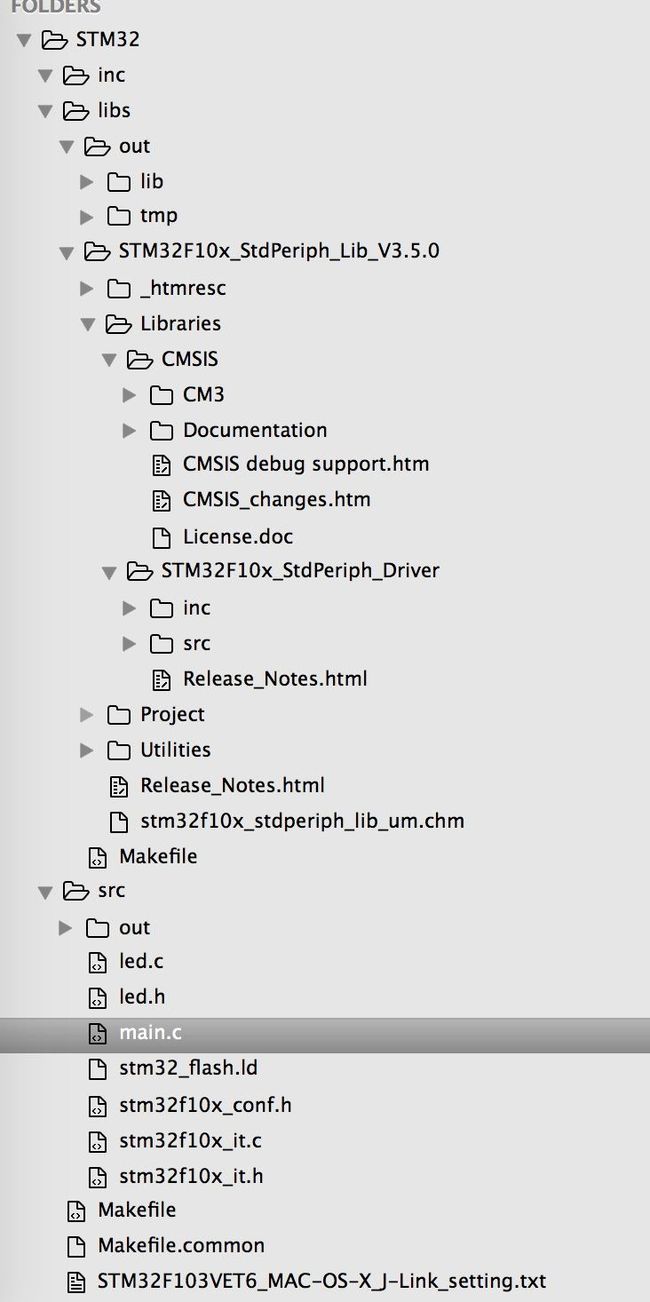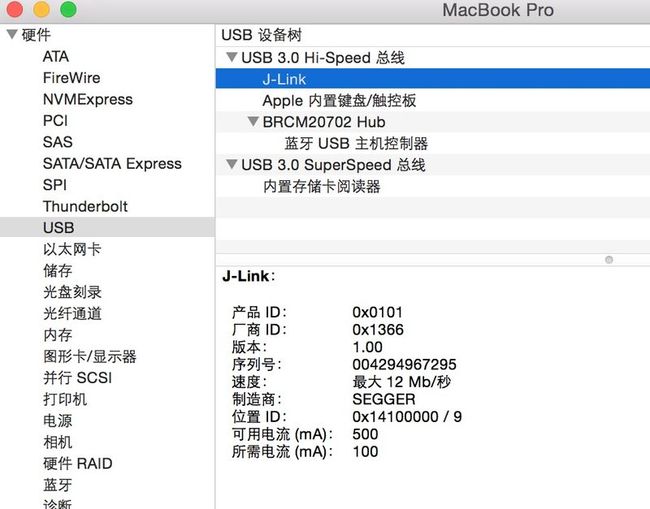MAC OS X平台搭建STM32开发环境
本人用MAC主要是做开发用,其实MAC平台只要不是用来开发Windows或者是嵌入式的话,做其他任何开发都比较舒服,至少我认为比在windows上要舒服的多。但是坑爹的事情也有,就是如果做嵌入式开发就比较蛋疼了。没办法,蛋疼归蛋疼,该做的也还是要做的。
本人手头上有一块STM32F103VET6的开发板,如果在windows下,那么轻松愉快,装个KeilMDK或者IAR for ARM就搞定了。但是在Mac OS X以及Linux下,就要用Makefile来管理开发了,这些平台上可没有非常方便的IDE供我们来选择。
好了,废话不多说,下面就进入正题。
一、准备工作
至少要准备一下软件,XCode,arm-none-eabi-gcc以及J-Link for MAC。我用的软件版本如下:
XCode6.x (AppStore 直接安装就好了)
gcc-arm-none-eabi-4_8-2014q3-20140805-mac.tar (VeryARM上下载,各个平台都有)
JLink_MacOSX_V500k.pkg (https://www.segger.com/jlink-software.html 这个地方可以下载)
二、环境配置
好了,安装包都准备好了吧?先讲gcc-arm-none-eabixxx这个包解压到你自已方便的位置,并在.bash_profile中添加如下环境变量:
export PATH=$PATH:$(ARM-TOOLS-ROOT)/bin其中$(ARM-TOOLS-ROOT)代表工具链解压之后的根目录,请用绝对路径并且路径名不要包含空格。完成之后在shell上执行如下指令使得以上设置的环境变量有效:
$ source .bash_profile完成之后可以在shell中执行如下命令查看时候安装成功:
$ arm-none-eabi-gcc -v如果安装成功,此时会再shell中打印出一堆的gcc的版本信息,如果失败,应该会打印此命令找不到之类的信息,那么肯定是环境变量设置出错。
此时编译工具链已经安装完成,那么再将JLink驱动装上就好了,这个与一般的其他软件安装过程一样。如果安装成功,应该会在/usr/bin下面找到JLinkExe,JFlashSPI等等可执行文件的。
三、代码示例
本人使用代码目录结构如下图:
这里主要贴一下Makefile,这些Makefile也是在网上参考了其他人并经过加工而成。主要的Makefile有三个,
Makefile.common这个是公共配置文件,STM32目录下得Makefile以及libs下得Makefile。
1、Makefile.common
# include Makefile #This file is included in the general Makefile, the libs Makefile and the src Makefile #Different optimize settings for library and source files can be realized by using arguments #Compiler optimize settings: # -O0 no optimize, reduce compilation time and make debugging produce the expected results (default). # -O1 optimize, reduce code size and execution time, without much increase of compilation time. # -O2 optimize, reduce code execution time compared to ‘O1’, increase of compilation time. # -O3 optimize, turns on all optimizations, further increase of compilation time. # -Os optimize for size, enables all ‘-O2’ optimizations that do not typically increase code size and other code size optimizations. #Recommended optimize settings for release version: -O3 #Recommended optimize settings for debug version: -O0 #Valid parameters : # OptLIB=0 --> optimize library files using the -O0 setting # OptLIB=1 --> optimize library files using the -O1 setting # OptLIB=2 --> optimize library files using the -O2 setting # OptLIB=3 --> optimize library files using the -O3 setting # OptLIB=s --> optimize library files using the -Os setting # OptSRC=0 --> optimize source files using the -O0 setting # OptSRC=1 --> optimize source files using the -O1 setting # OptSRC=2 --> optimize source files using the -O2 setting # OptSRC=3 --> optimize source files using the -O3 setting # OptSRC=s --> optimize source files using the -Os setting # all --> build all # libs --> build libs only # src --> build src only # clean --> clean project # tshow --> show optimize settings #Example: # make OptLIB=3 OptSRC=0 all tshow #TOP=$(shell readlink -f "$(dir $(lastword $(MAKEFILE_LIST)))") TOP = /Users/zhj/Developer/STM32 PROGRAM = stm32_project LIBDIR = $(TOP)/libs #Adust the following line to the library in use STMLIB = $(LIBDIR)/STM32F10x_StdPeriph_Lib_V3.5.0/Libraries #Adjust TypeOfMCU in use, see CMSIS file "stm32f10x.h" #STM32F103RBT (128KB FLASH, 20KB RAM) --> STM32F10X_MD #STM32F103RET (512KB FLASH, 64KB RAM) --> STM32F10X_HD #STM32F103ZET (512KB FLASH, 64KB RAM) --> STM32F10X_HD TypeOfMCU = STM32F10X_HD # Tool chains settings. TOOLCHAINS_PREFIX = arm-none-eabi CC = $(TOOLCHAINS_PREFIX)-gcc ld = $(TOOLCHAINS_PREFIX)-ld -v OBJCOPY = $(TOOLCHAINS_PREFIX)-objcopy AR = $(TOOLCHAINS_PREFIX)-ar GDB = $(TOOLCHAINS_PREFIX)-gdb INCLUDE =-I$(TOP)/inc INCLUDE +=-I$(STMLIB)/CMSIS/CM3/CoreSupport INCLUDE +=-I$(STMLIB)/CMSIS/CM3/DeviceSupport/ST/STM32F10x INCLUDE +=-I$(STMLIB)/STM32F10x_StdPeriph_Driver/inc COMMONFLAGS = -g -mcpu=cortex-m3 -mthumb COMMONFLAGSlib = $(COMMONFLAGS) #Commands for general Makefile and src Makefile ifeq ($(OptSRC),0) COMMONFLAGS += -O0 InfoTextSrc = src (no optimize, -O0) else ifeq ($(OptSRC),1) COMMONFLAGS += -O1 InfoTextSrc = src (optimize time+ size+, -O1) else ifeq ($(OptSRC),2) COMMONFLAGS += -O2 InfoTextSrc = src (optimize time++ size+, -O2) else ifeq ($(OptSRC),s) COMMONFLAGS += -Os InfoTextSrc = src (optimize size++, -Os) else COMMONFLAGS += -Os InfoTextSrc = src (full optimize, -O3) endif CFLAGS += $(COMMONFLAGS) -Wall -Werror $(INCLUDE) CFLAGS += -D$(TypeOfMCU) CFLAGS += -DUSE_STDPERIPH_DRIVER #Commands for libs Makefile ifeq ($(OptLIB),0) COMMONFLAGSlib += -O0 InfoTextLib = libs (no optimize, -O0) else ifeq ($(OptLIB),1) COMMONFLAGSlib += -O1 InfoTextLib = libs (optimize time+ size+, -O1) else ifeq ($(OptLIB),2) COMMONFLAGSlib += -O2 InfoTextLib = libs (optimize time++ size+, -O2) else ifeq ($(OptLIB),s) COMMONFLAGSlib += -Os InfoTextLib = libs (optimize size++, -Os) else COMMONFLAGSlib += -O3 InfoTextLib = libs (full optimize, -O3) endif CFLAGSlib += $(COMMONFLAGSlib) -Wall -Werror $(INCLUDE) CFLAGSlib += -D$(TypeOfMCU) CFLAGSlib += -DUSE_STDPERIPH_DRIVER2、libs下的Makefile是用来编译STM32标准驱动库的,生成的中间文件在libs/out/tmp中,而最后成果在libs/out/lib中。请看具体内容:
# libs Makefile include ../Makefile.common INC = -I$(TOP)/src LIBS = libstm32.a OBJOUTDIR = $(LIBDIR)/out/tmp LIBOUTDIR = $(LIBDIR)/out/lib MY_C_SOURCES := $(wildcard $(STMLIB)/CMSIS/CM3/CoreSupport/*.c) MY_C_SOURCES += $(wildcard $(STMLIB)/CMSIS/CM3/DeviceSupport/ST/STM32F10x/*.c) MY_C_SOURCES += $(wildcard $(STMLIB)/STM32F10x_StdPeriph_Driver/src/*.c) SOURCES := $(patsubst %.c, %.c, $(MY_C_SOURCES)) MY_S_SOURCES := $(STMLIB)/CMSIS/CM3/DeviceSupport/ST/STM32F10x/startup/gcc_ride7/startup_stm32f10x_hd.s S_OBJS := $(patsubst %.s, %.o, $(MY_S_SOURCES)) OBJS := $(patsubst %.c, %.o, $(SOURCES)) OBJSWITHOUTDIR := $(patsubst %.c, $(OBJOUTDIR)/%.o, $(notdir $(SOURCES))) OBJSWITHOUTDIR += $(OBJOUTDIR)/$(notdir $(S_OBJS)) all: $(LIBS) $(LIBS):$(OBJS) $(S_OBJS) $(AR) cr $(LIBOUTDIR)/$@ $(OBJSWITHOUTDIR) .PHONY: clean tshow clean: rm -f $(LIBOUTDIR)/*.a rm -f $(OBJOUTDIR)/*.o show: @echo $(MY_C_SOURCES) @echo @echo $(SOURCES) @echo @echo $(OBJS) @echo tshow: @echo "#####################################################################################" @echo "################# optimize settings: $(InfoTextLib), $(InfoTextSrc)" @echo "#####################################################################################" $(S_OBJS): $(MY_S_SOURCES) $(CC) $(CFLAGSlib) -c $< -o $(OBJOUTDIR)/$(notdir $@) %.o:%.c $(CC) $(CFLAGSlib) $(INC) -c $< -o $(OBJOUTDIR)/$(notdir $@)3、编译二进制可执行文件的Makefile,就在与Makefile.common同级的目录中。它编译的结果包括中间文件都在src/out目录中,这里的编译会用到libs下生成的libstm32.a文件。
# general Makefile include Makefile.common PROGRAM = stm32_project LIBS = libstm32.a OBJOUTDIR = $(TOP)/src/out/tmp BINOUTDIR = $(TOP)/src/out/bin LIBOUTDIR = $(LIBDIR)/out/lib INC = -I$(TOP)/src LDFLAGS=$(COMMONFLAGS) -fno-exceptions -ffunction-sections -fdata-sections \ -L$(LIBOUTDIR) -Wl,--no-whole-archive -lstm32 \ -nostartfiles -Wl,--gc-sections,-T$(TOP)/src/stm32_flash.ld MY_C_SOURCES := $(wildcard $(TOP)/src/*.c) SOURCES := $(patsubst %.c, %.c, $(MY_C_SOURCES)) OBJS := $(patsubst %.c, %.o, $(SOURCES)) OBJSWITHOUTDIR := $(patsubst %.c, $(OBJOUTDIR)/%.o, $(notdir $(SOURCES))) .PHONY: libs clean tshow show all: libs src libs: $(MAKE) -C $@ src: $(OBJS) $(CC) -o $(BINOUTDIR)/$(PROGRAM).elf $(OBJSWITHOUTDIR) $(LDFLAGS) $(OBJCOPY) -O ihex $(BINOUTDIR)/$(PROGRAM).elf $(BINOUTDIR)/$(PROGRAM).hex $(OBJCOPY) -O binary $(BINOUTDIR)/$(PROGRAM).elf $(BINOUTDIR)/$(PROGRAM).bin arm-none-eabi-readelf -a $(BINOUTDIR)/$(PROGRAM).elf > $(BINOUTDIR)/$(PROGRAM).info_elf arm-none-eabi-size -d -B -t $(BINOUTDIR)/$(PROGRAM).elf > $(BINOUTDIR)/$(PROGRAM).info_size arm-none-eabi-objdump -S $(BINOUTDIR)/$(PROGRAM).elf > $(BINOUTDIR)/$(PROGRAM).info_code arm-none-eabi-nm -t d -S --size-sort -s $(BINOUTDIR)/$(PROGRAM).elf > $(BINOUTDIR)/$(PROGRAM).info_symbol %.o:%.c $(CC) $(CFLAGS) $(INC) -c $< -o $(OBJOUTDIR)/$(notdir $@) clean: $(MAKE) -C libs $@ -rm -r $(OBJOUTDIR)/*.o @cd $(BINOUTDIR) -rm -f $(PROGRAM).elf $(PROGRAM).hex $(PROGRAM).bin $(PROGRAM).info_elf $(PROGRAM).info_size -rm -f $(PROGRAM).info_code -rm -f $(PROGRAM).info_symbol @cd .. show: @echo $(MY_C_SOURCES) @echo @echo $(SOURCES) @echo @echo $(OBJS) @echo @echo $(OBJSWITHOUTDIR) tshow: @echo "######################################################################################################" @echo "################# optimize settings: $(InfoTextLib), $(InfoTextSrc)" @echo "######################################################################################################"4、当文件都配置妥当,那么就可以在STM32这一级目录中执行make指令,如果一起正常就会在src/out/bin下生成一个stm32_project.bin的文件,这个文件就是最终要烧录到开发板的二进制文件。
5、还要注意的是,注意程序在链接的时候需要一个链接脚本,这个脚本定义了链接过程中所有代码的定位问题。所以一定要注意其配置。这个文件在STM32标准驱动库中的Project/STM32F10x_StdPerihp_Template/TrueSTUDIO中每一EVAL目录中有示例,主要区别就是目标MCU的RAM/FLASH的大小。一定注意,我使用的STM32F103VET6是512KB flash/64KB RAM,其链接脚本(stm32_flash.ld)如下:
/*
*****************************************************************************
**
** File : stm32_flash.ld
**
** Abstract : Linker script for STM32F103ZE Device with
** 512KByte FLASH, 64KByte RAM
**
** Set heap size, stack size and stack location according
** to application requirements.
**
** Set memory bank area and size if external memory is used.
**
** Target : STMicroelectronics STM32
**
** Environment : Atollic TrueSTUDIO(R)
**
** Distribution: The file is distributed “as is,” without any warranty
** of any kind.
**
** (c)Copyright Atollic AB.
** You may use this file as-is or modify it according to the needs of your
** project. Distribution of this file (unmodified or modified) is not
** permitted. Atollic AB permit registered Atollic TrueSTUDIO(R) users the
** rights to distribute the assembled, compiled & linked contents of this
** file as part of an application binary file, provided that it is built
** using the Atollic TrueSTUDIO(R) toolchain.
**
*****************************************************************************
*/
/* Entry Point */
ENTRY(Reset_Handler)
/* Highest address of the user mode stack */
_estack = 0x20010000; /* end of 64K RAM */
/* Generate a link error if heap and stack don't fit into RAM */
_Min_Heap_Size = 0; /* required amount of heap */
_Min_Stack_Size = 0x200; /* required amount of stack */
/* Specify the memory areas */
MEMORY
{
FLASH (rx) : ORIGIN = 0x08000000, LENGTH = 512K
RAM (xrw) : ORIGIN = 0x20000000, LENGTH = 64K
MEMORY_B1 (rx) : ORIGIN = 0x60000000, LENGTH = 0K
}
/* Define output sections */
SECTIONS
{
/* The startup code goes first into FLASH */
.isr_vector :
{
. = ALIGN(4);
KEEP(*(.isr_vector)) /* Startup code */
. = ALIGN(4);
} >FLASH
/* The program code and other data goes into FLASH */
.text :
{
. = ALIGN(4);
*(.text) /* .text sections (code) */
*(.text*) /* .text* sections (code) */
*(.rodata) /* .rodata sections (constants, strings, etc.) */
*(.rodata*) /* .rodata* sections (constants, strings, etc.) */
*(.glue_7) /* glue arm to thumb code */
*(.glue_7t) /* glue thumb to arm code */
KEEP (*(.init))
KEEP (*(.fini))
. = ALIGN(4);
_etext = .; /* define a global symbols at end of code */
} >FLASH
.ARM.extab : { *(.ARM.extab* .gnu.linkonce.armextab.*) } >FLASH
.ARM : {
__exidx_start = .;
*(.ARM.exidx*)
__exidx_end = .;
} >FLASH
.ARM.attributes : { *(.ARM.attributes) } > FLASH
.preinit_array :
{
PROVIDE_HIDDEN (__preinit_array_start = .);
KEEP (*(.preinit_array*))
PROVIDE_HIDDEN (__preinit_array_end = .);
} >FLASH
.init_array :
{
PROVIDE_HIDDEN (__init_array_start = .);
KEEP (*(SORT(.init_array.*)))
KEEP (*(.init_array*))
PROVIDE_HIDDEN (__init_array_end = .);
} >FLASH
.fini_array :
{
PROVIDE_HIDDEN (__fini_array_start = .);
KEEP (*(.fini_array*))
KEEP (*(SORT(.fini_array.*)))
PROVIDE_HIDDEN (__fini_array_end = .);
} >FLASH
/* used by the startup to initialize data */
_sidata = .;
/* Initialized data sections goes into RAM, load LMA copy after code */
.data : AT ( _sidata )
{
. = ALIGN(4);
_sdata = .; /* create a global symbol at data start */
*(.data) /* .data sections */
*(.data*) /* .data* sections */
. = ALIGN(4);
_edata = .; /* define a global symbol at data end */
} >RAM
/* Uninitialized data section */
. = ALIGN(4);
.bss :
{
/* This is used by the startup in order to initialize the .bss secion */
_sbss = .; /* define a global symbol at bss start */
__bss_start__ = _sbss;
*(.bss)
*(.bss*)
*(COMMON)
. = ALIGN(4);
_ebss = .; /* define a global symbol at bss end */
__bss_end__ = _ebss;
} >RAM
PROVIDE ( end = _ebss );
PROVIDE ( _end = _ebss );
/* User_heap_stack section, used to check that there is enough RAM left */
._user_heap_stack :
{
. = ALIGN(4);
. = . + _Min_Heap_Size;
. = . + _Min_Stack_Size;
. = ALIGN(4);
} >RAM
/* MEMORY_bank1 section, code must be located here explicitly */
/* Example: extern int foo(void) __attribute__ ((section (".mb1text"))); */
.memory_b1_text :
{
*(.mb1text) /* .mb1text sections (code) */
*(.mb1text*) /* .mb1text* sections (code) */
*(.mb1rodata) /* read-only data (constants) */
*(.mb1rodata*)
} >MEMORY_B1
/* Remove information from the standard libraries */
/DISCARD/ :
{
libc.a ( * )
libm.a ( * )
libgcc.a ( * )
}
}
四、使用J-Link下载代码到MCU
好了,现在我们拥有一个可以烧录的stm32_project.bin文件。现在请讲J-LINK连接到你的MAC并且为开发供电。
在如何J-LINK连接正常,那么系统信息中会显示J-Link设备。我的设备如下:
现在可以使用安装好的J-LINK驱动将bin文件下载到MCU得内置flash中。请先在shell中进入的工程根目录,并在shell执行如下命令:
$ JLinkExe J-Link>现在您可以在此命令行中执行相关命令来下载bin文件。首先要执行device这条指令用来指定您的目标MCU,我的是STM32F103VET6,所以如下:
J-Link > exec device=STM32F103VE是否成功会有消息提示,请仔细阅读。
在使用以上命令选择了目标MCU之后,就可以下载bin文件了,如下:
J-Link > loadbin src/out/bin/stm32_project.bin 0x08000000其中loadbin为命令,紧接着为文件名,再接着为目标MCU内置Flash的起始地址。这个地址具体的MCU不同会有所不通过,但应该与stm32_flash.ld中memory section中Flash描述的起始地址一样,及如下:
/* Specify the memory areas */
MEMORY
{
FLASH (rx) : ORIGIN = 0x08000000, LENGTH = 512K
RAM (xrw) : ORIGIN = 0x20000000, LENGTH = 64K
MEMORY_B1 (rx) : ORIGIN = 0x60000000, LENGTH = 0K
} 其中的 FLASH(rx) 中的ORIGIN就表示Flash的起始地址,上述命令中的地址应该与其保持一致。如果这条命令执行成功就会打印出OK等字样,并且会打印相关打印的时间信息等。
大功告成,如此一来,只要将MCU复位,就可以看到代码的执行效果了。
五、总结
本文主要介绍了Mac OS X下如何搭建STM32的开发环境。其实本文中的Makefile还是不太完善,因为每次执行make所有的文件都会重新编译,但是不影响功能,相关完善就不再发文,请知悉。文中内容均为原创,只有Makefile.common的部分内容摘录自网络,转载请注明出处,谢谢。

